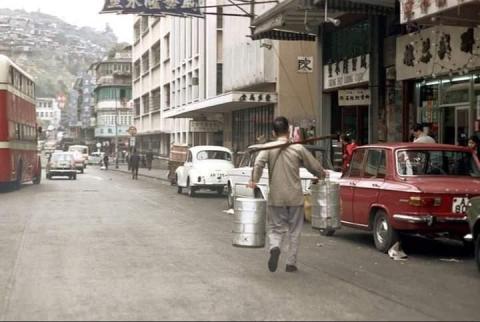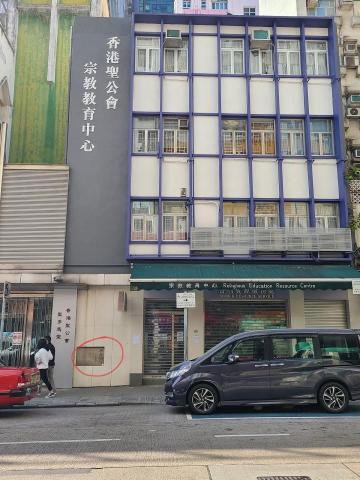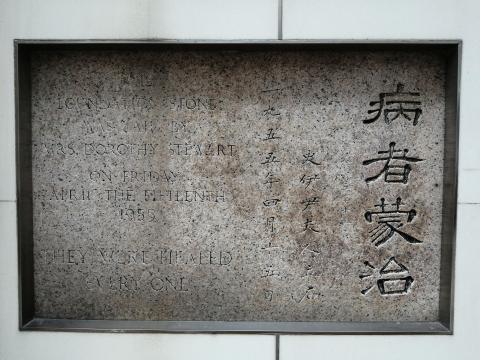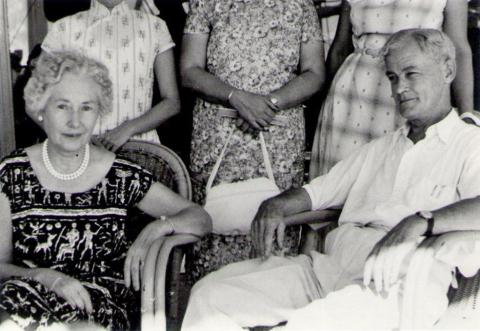Guest author Geoffrey Charles Emerson unearths the history of a small, silver trowel:
In January 2021, I received an email from Michael Stewart in England. Michael is the son of former St Paul’s Headmaster (1930 – 1958) Evan G. Stewart. Michael was born in Hong Kong in 1931, so 90 this year, and he is now retired in southern England near to his two daughters, Frances and Isobel. Ever since 2008, when Michael visited Hong Kong for Speech Day and for the Stewart Dinner in the school hall, in honour of Michael’s father and his father’s older brother, Michael’s uncle, Rev. A.D. Stewart, Headmaster of St Paul’s before E.G., Michael and I have kept up an active correspondence.
Michael wrote to me because recently he and his daughters have been going through family records and mementos, and they were puzzled by a silver trowel with a Chinese inscription on it, but no English. Longman’s dictionary defines a trowel as “a tool with a flat blade for spreading cement”, and trowels are often used for laying foundation stones. They are usually presented as a souvenir to the person, always a VIP, laying the stone. Michael sent me a photo and asked if I could provide a translation of the Chinese.
A friend of mine, Sylvia Fok Midgett, was happy to assist, and not only did she provide a good translation, but she also found on the Web photos of the stone and the building, which still remains in Shamshuipo! Another friend visited the site today and took photos for me. The translation reads: “To Commemorate Hardship. Medical Centre Ceremony. Mrs Stewart, Keepsake”. The stone was for an Anglican / Sheng Kung Hui (SKH) medical centre at 45 Berwick Street, Shamshuipo, Kowloon. The English name of the centre was St. Thomas Medical Centre, and the date was 15 April 1955.
St. Thomas’ Medical Centre in the 1950s
(found on the internet, original source unknown)
The Foundation Stone (bottom left) and Resource Centre today
(credit: Victor Li)
The Foundation Stone
Without doubt in 1955 a medical centre was needed in Shamshuipo. At that time, the Bishop of Hong Kong was Ronald Hall, who is remembered for his efforts to help the poorer people of Hong Kong. In 1955, Hong Kong was crowded with refugees and still recovering from the war years, so a medical centre was needed in Shamshuipo. With the later growth of hospitals and public clinics, this centre was perhaps less needed and today the building is used as a SKH Religious Education Resource Centre.
One question which came to Michael’s mind was why the wife of the Headmaster of St Paul’s College, then as now situated in Sai Ying Pun far from Shamshuipo , was asked to lay the stone. We will probably never know for sure, but my conjecture is that Bishop Hall was a very busy man and perhaps had another duty that day, so he asked E.G. and his wife to officiate for him. It also is interesting that Michael told me he thought his father had once told him that he had used the trowel to lay the stone, but now we know it was Michael’s mother, Dorothy Sarah Stewart (nee Lander). She, by the way, was the daughter of Bishop Gerald Lander (Bishop 1907-1920), who was Head of St Paul’s College prior to A.D. Stewart.
E.G. Stewart & Dorothy in the 1950s
Michael Stewart & his daughters Frances and Isobel (and the dog Liffey) 2020
History! One never knows when history will appear, and stories such as this make the history of St Paul’s meaningful and fascinating. I am grateful, of course, to all those who helped me uncover this story of a trowel. I hope many more stories will crop up not only from former staff but of course from former students too. St Paul’s has such a long and interesting history. Please, if you can help contribute a story, please do.
A famous historian once contributed the phrase “history by the ounce”. Seemingly minor things can make history really interesting and come to life. (Forget all those treaties and dates!) A small trowel...a fascinating story.
Born in the United States, in upstate New York, Geoffrey Charles Emerson came to Hong Kong in 1964 to teach at St Paul's College, Bonham Road, Hong Kong. After serving as Vice Principal, Guidance Counselor and teacher, he retired from the College and lives in the New Territories, Hong Kong.
In the 1970s, Geoffrey interviewed 23 former internees of Stanley Internment Camp as part of the research for his MPhil thesis. An exapanded version of his thesis was later published by HKUP as the book Hong Kong Internment, 1942-1945, Life in the Japanese Civilian Camp at Stanley.
More recently, Geoffrey penned the above article for the St Paul's College newsletter. Thank you to Michael and Geoffrey for sharing this story with us.
Further reading:
- Evan George Stewart (coincidentally, contributor Tideswell27 has just added a biography of this man, including a photo of his many medals)
- Dorothy Sarah Stewart (nee Lander)
- Arthur Dudley Stewart
- St Paul's College: The initial location at Glenealy, and the current location on Bonham Road
- St. Thomas Medical Centre
- More trowels, and lots more foundation stones






Inscriptions on silver trowel
I do not quite concur with the translation of the inscriptions.
The words on the right column are "念劬勞醫療院奠基禮", "念劬勞醫療院" was the Chinese name of the medical center, "奠基禮" is the foundation stone laying ceremony.
The date should be April 15, 1955, and not April 13.
Anglican/Sheung Kung Hui - Anglican in Chinese is 聖公會, 聖公會 is then transliterated back as "Sheung Kung Hui", I think just Anglican/聖公會 would be less confusing.
Addendum: The proper translation of the right-hand side column of the inscriptions on the silver trowel should be "St. Thomas' Clinic foundation stone laying ceremony"
S.K.H
Actually the usual transliteration of 聖公會 in Hong Kong is "Sheng Kung Hui" and is often shortened to simply S.K.H. It is a very common and well recognised term in HK for the Anglican church organisation. Why would its use be confusing?
Foundation stone
This is actually my local neighbourhood (also my son attended St Thomas Primary, the original building of which is next door but repurposed) so I took the liberty of taking some additional photos of the stone.
Updates
Thank you both for your feedback. I've made a few edits:
I'll also ask Geoff to take a look in case he'd like to make any other changes.
I was not aware that S.K.H.
I was not aware that S.K.H. was used in HK instead of its original proper name. Still, it does not make much sense to me. This is akin to a John Smith being transliterated as 約翰·史密夫 and then transliterated back as York Hon See Met Foo, and he becomes known by this YHSMF name instead of his original John Smith name even among non-Chinese speakers.
HKSKH
Not instead of, it's just a commonly used abbreviation for the sake of...brevity. Other examples would be CCC (Church of Christ in China), TWGH (Tung Wah Group of Hospitals), PLK (Po Leung Kuk) etc
Website: http://www.hkskh.org/index.aspx?lang=1
St. Thomas' Clinic
The name of the clinic - the first 6 words of the inscription on the trowel, 念劬勞醫療院, is clearly visible on the wall here.
St. Thomas' Clinic
Greetings! The four Chinese characters on the right of the foundation stone caught my eye because the third word seems to me as something related to Mongolia. I looked it up and noted it can mean receive or give, making the phrase (their mission) "Sick person receive/give treatment", a skillful choice of word. I visited my street-friends here in 1956, and housings on the north side were being built at the time. Regards, Peter
Old Photos of St. Thomas Church ~1962
Source: From the 聖公會聖多馬堂五十周年特輯 ( S.K.H. St. Thomas Church 50th Anniversary booklet)
Foundation Stone Inscription's Biblical Reference
使徒行傳第五章 New Testament - Acts of the Apostles - Chapter 5-16
【徒五16】「還有許多人,帶著病人,和被污鬼纏磨的,從耶路撒冷四圍的城邑來,全都得了醫治。」
The phrase 病者蒙治 in the inscription referred to these acts.
【KJV 】 There came also a multitude out of the cities round about unto Jerusalem, bringing sick folks, and them which were vexed with unclean spirits: and they were healed every one.
HKSKH
Hi philk,
Hong Kong Sheng Kung Hui is used INSTEAD OF Anglican Church, AC would be a shorter abbreviation.
The name 聖公會 is also used in Japan (Nippon Sai Ko Kai 日本聖公会), Taiwan, Macau, and Korea as the name of the church.
HKSKH
Oh I understand, many apologies. I suspect AC wouldn't be popular though as people might confuse it with air-conditioning
A very meaningful trowel
In Chinese, the term "劬勞" inscribed on the trowel is to extol the hardship and selfless love specifically and only of the parent to their sons and daughters. Therefore the use of "念劬勞" (in memory of the devotion and love of the parent) is by the children praising their father and mother.
This is the meaning behind the story why it was named this way in Chinese while in English it still carried name "St. Thomas" as shown from the photo of the building. There were newspaper reports from Wah Kiu Yat Po on 27 August and 3 September 1955 that the clinic was open on 2 September 1955. The ceremony was officiated by Bishop Hall and Mr Wong Cheuk Um (黃焯菴), the gentleman who donated for this clinic in memory of his father Mr Wong Ming Him (黃鳴謙) and mother Ms Ng Ching Yee (吳靜儀), a way to show his memory of the parental love.
Wong Cheuk Um was an alumni of St. Paul's, and he also donated a building at the school campus, which was named after his father as well.
念劬勞醫療院 Foundation stone
念劬勞醫療院 Foundation stone (Source from HoneyCelia's blog)
Name of medical clinic 念劬勞
I believe the term 劬勞 is also used to describe one's dedicated service for his/her country, as in 劬勞報國.
Lost in translation
Anglican Church translated into Chinese as 聖公會, which in turn was transliterated back into English as Sheng Kung Hui.
A somewhat similar scenario happened with the Olympic track cycling event Keirin. This racing format originated in Japan and was named ケイリン or 競輪. It was phonetically translated into English as Keirin, which in turn was transliterated into Chinese as 凱琳, a term with no real meaning. Retaining the Japanese Kanji term 競輪 would be much more appropriate.
The HK slang term "打茄輪" probably also was derived from this.
Silver Trowel post - 3 Sept 1955 Foundation stone by Herman
Is this stone still there? Perhaps on the church building?
Re: Silver Trowel post - 3 Sept 1955 Foundation stone by Herman
Yes. The foundation stone is on the right side after entering the church building.
Updated photo on April 3 2023 by Herman
St Thomas Church Shamshuipo
Thanks for the comment, Herman. Glad you are so interested. I hope more comments will be made.